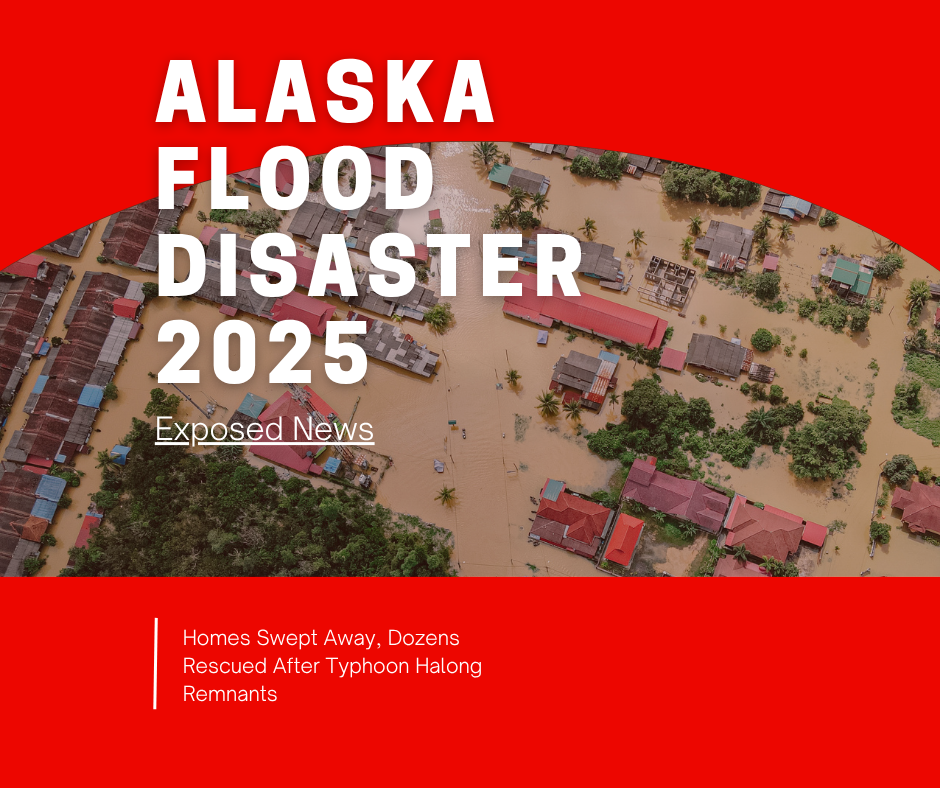A Sudden Disaster Strikes Alaska’s Remote Coast
Western Alaska is reeling after catastrophic flooding struck the Yukon-Kuskokwim Delta on Sunday, sweeping entire homes into swollen rivers and forcing families to flee in the dark. The storm, powered by the remnants of Typhoon Halong, brought hurricane-force winds and surging tides that left small coastal villages devastated.
Communities like Kipnuk, Kwigillingok, and Tuntutuliak faced waves of up to eight feet, while powerful currents tore through neighborhoods and destroyed vital infrastructure. Eyewitness videos shared on social media show wooden homes floating down flooded streets as residents waded to higher ground carrying only essential belongings.
“This is the worst flooding I’ve ever seen here,” said James Napoka, a longtime Kipnuk resident who watched his cousin’s home collapse into the river. “The water just kept coming — faster than we could move.”
How the Storm Formed: Typhoon Halong’s Dangerous Afterlife
The disaster was triggered by the extratropical remnants of Typhoon Halong, which formed over the Pacific and transitioned into a massive low-pressure system as it approached Alaska’s western coast. According to the National Weather Service (NWS), the system created an unusual combination of heavy rainfall, storm surge, and sustained winds over 70 mph, pushing seawater inland and overwhelming riverbanks.
NOAA meteorologist Jessica Owens explained, “This event rivals the 2022 Bering Sea storm in terms of pressure and wind speed. The difference is the direction of impact — Halong’s remnants pushed water into the delta region, where drainage is already limited.”
Experts warn that warmer ocean temperatures are intensifying the moisture content of such post-tropical storms, increasing flood risk in Arctic and sub-Arctic communities that were once shielded by ice and cold air barriers.
Entire Homes Swept Away: Impact on Local Communities
Initial assessments from Alaska State Troopers confirm that over 40 homes in coastal villages have been damaged or destroyed, with at least eight completely swept away by floodwaters. Power outages, contaminated wells, and blocked roads have cut off several communities from emergency support.
In Kwigillingok, the local school — one of the village’s few elevated structures — has been converted into a temporary shelter for displaced families. “We have children, elders, and pets here,” said Principal Mary Ann Chugak. “We’re running on backup generators, but we need clean water and medical supplies soon.”
The Alaska National Guard has conducted multiple air rescues using Black Hawk helicopters, airlifting stranded residents from rooftops and isolated areas where roads remain submerged.
Emergency Response and Federal Assistance
Governor Mike Dunleavy declared a state of emergency early Monday, activating disaster response teams across the western coast.
The Federal Emergency Management Agency (FEMA) and U.S. Coast Guard are coordinating relief operations, focusing on food distribution, temporary housing, and restoring communication lines.
“Getting aid to these remote communities is always a challenge,” said FEMA spokesperson Laura McKinney. “Many are only accessible by air or boat, and flood damage has made those routes unstable. We’re deploying amphibious vehicles and airlifts to reach affected areas.”
The Red Cross has opened emergency shelters in Bethel and Hooper Bay, with volunteers providing blankets, meals, and trauma counseling for families who’ve lost their homes.
Climate Experts Warn: A Preview of Alaska’s Future
Climate researchers are linking the intensity of this flooding to the accelerating impacts of global warming in the Arctic. Rising sea levels, shrinking permafrost, and warmer oceans have created a “perfect storm” for more frequent and severe flooding.
Dr. Emily Larson, a climate systems scientist at the University of Alaska Fairbanks, noted,
“Alaska is warming at more than twice the global average. These kinds of storms, once considered freak events, are becoming part of a new normal. Infrastructure built decades ago simply wasn’t designed for these conditions.”
Recent studies from NOAA show that Alaska’s coastal erosion rate has doubled since 2010, with over 30 communities now classified as “high-risk” for relocation due to chronic flooding and permafrost thaw.
Historical Context: Lessons from Past Floods
While Alaska is no stranger to coastal storms, the 2025 Halong Floods are among the worst in recent memory.
In 2022, a powerful Bering Sea cyclone caused major damage in Nome and surrounding villages, but the current disaster has affected a wider region, stretching from Hooper Bay to Toksook Bay — more than 200 miles of coastline.
Unlike glacier-fed floods, which are seasonal and predictable, these large ocean-driven surges are harder to forecast and hit without warning, especially in low-lying deltas.
Local leaders have long called for updated flood mapping, stronger seawalls, and better early-warning systems, many of which remain underfunded.
Human Stories: Resilience Amid Ruin
In Kipnuk, villagers are already rebuilding makeshift shelters using salvaged materials. Children help gather firewood, while volunteers set up soup kitchens powered by portable stoves. “We lost homes, but not hope,” said elder Marie Tuluk, wrapping herself in a donated blanket. “We’ve lived with this land for generations. We’ll survive again.”
Residents across the delta echo a common refrain — the need for long-term resilience, not just emergency relief. Many advocate for community-led relocation efforts to higher ground, a move that could take years but save lives in the future.
Government Outlook and Next Steps
State officials are assessing total damage, expected to exceed $100 million once infrastructure losses are included.
Reconstruction will likely require federal disaster funding and potentially new environmental adaptation plans for flood-prone villages.
As the storm’s remnants move inland, forecasters warn of continued rainfall and rising river levels through mid-week. The National Weather Service has extended flood warnings for multiple western river basins through October 16.
FAQ: Alaska Flooding 2025
Q1: What caused the flooding in Alaska?
The remnants of Typhoon Halong collided with a low-pressure system, creating storm surges and torrential rains that overwhelmed riverbanks and coastal defenses.
Q2: Which areas are worst affected?
Communities in the Yukon-Kuskokwim Delta, including Kipnuk, Kwigillingok, and Tuntutuliak, reported the heaviest damage.
Q3: Are there casualties or missing people?
As of early reports, no confirmed deaths, but multiple people remain missing and search operations are ongoing.
Q4: Is this linked to climate change?
Experts believe warmer oceans and rising sea levels intensified the storm’s impact, consistent with long-term Arctic warming trends.
Q5: How can people help?
Donations can be made via the Alaska Red Cross or State Disaster Relief Fund, both assisting with supplies and temporary housing.
Key Takeaway
The 2025 Alaska floods serve as a stark reminder that climate change is no longer a distant threat — it’s reshaping the state’s coastlines in real time. As homes vanish beneath rising waters, the focus now turns from emergency response to long-term adaptation, ensuring future generations can live safely on the land their ancestors built.







